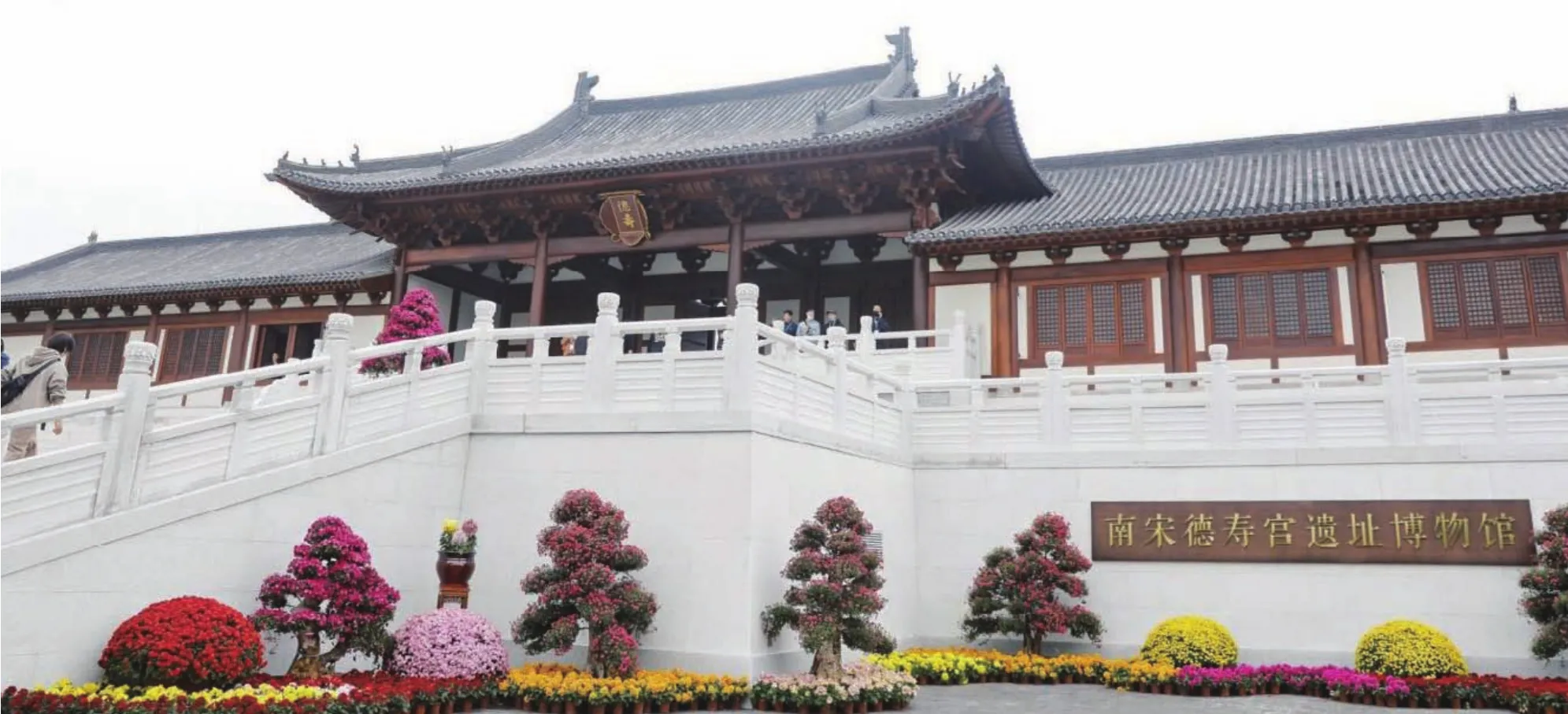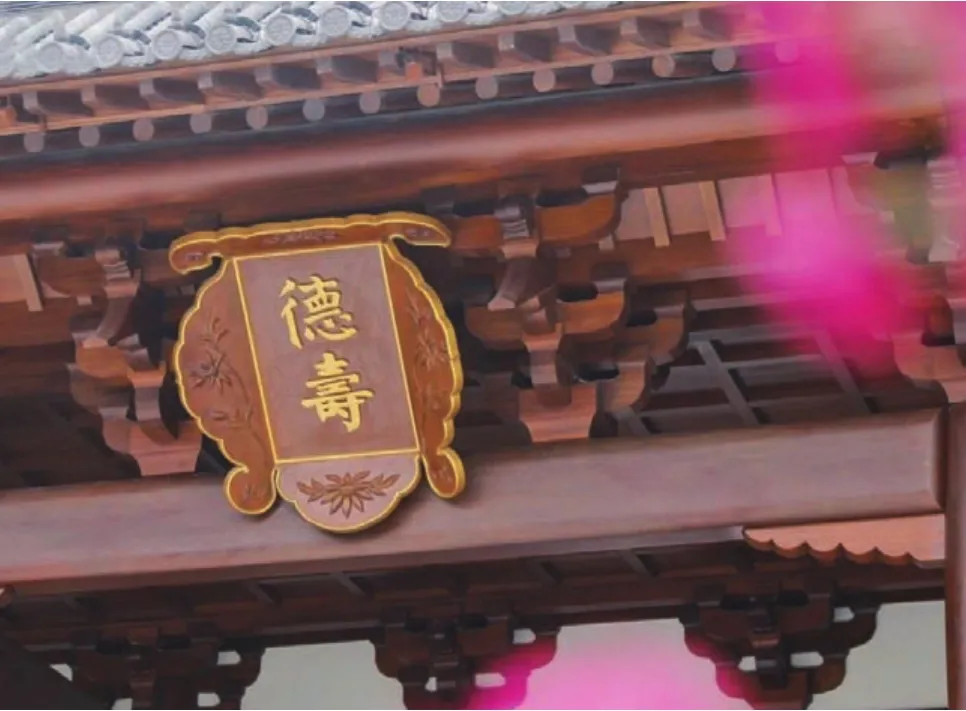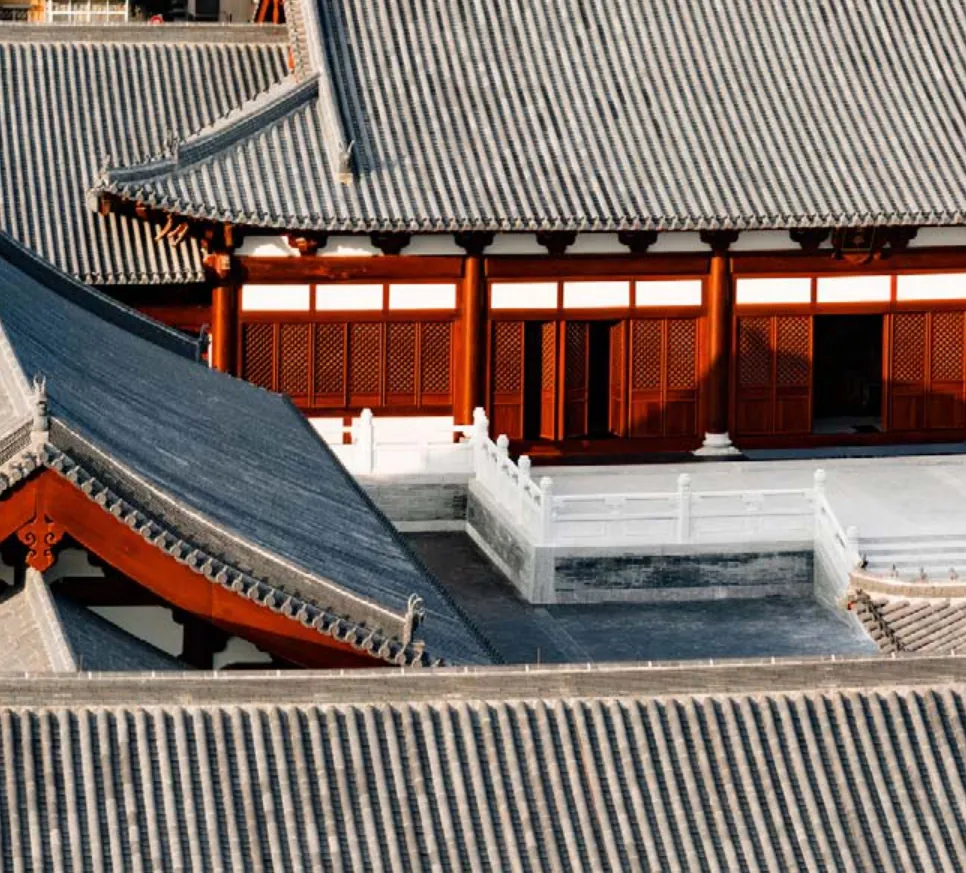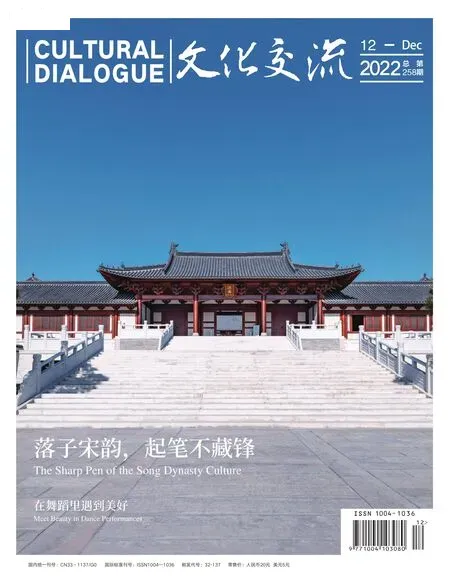德寿宫:那一瞥便是千年
文/周华诚

杭州南宋德寿宫遗址博物馆。The Southern Song Dynasty Deshou Palace Ruins Museum in Hangzhou city, Zhejiang province.
南宋德寿宫遗址博物馆开放后,许多游客趁着秋阳正好,排着队在德寿宫的红墙边“打卡”。那么,德寿宫何以凭“一墙之力”火出圈?德寿宫遗址博物馆开放后,对这座城市又有什么重要意义呢?
杭州的文化基因
宋韵,杭州城市文化血脉里隐藏的基因。杭州的城市格局塑造、饮食习惯、生活美学、文化艺术,都跟南宋一朝息息相关。
德寿宫是一扇窗,往窗内一瞥,便是千年风华。
1162年,宋高宗退位后移居“德寿宫”,时人称大内皇宫为“南内”,称德寿宫为“北内”。世事变迁,德寿宫在历史云烟中归于消逝,也被城市建设所层层叠压。八百多年后,这座德寿宫终于重新出现在世人面前。
德寿宫的遗址保护与文化展示,对于杭州这座城市意义重大。因为杭州城市文化、气质的形成,与南宋密不可分。德寿宫遗址作为南宋皇城遗址的一部分,是城市的珍贵遗存。它的保护发掘与地面建筑复原,对于杭州这座城市有着重要的意义。
倘要真正读懂杭州,除了一座西湖,还要有一座德寿宫。
望江路以北,中河以东,直吉祥巷以西,梅花碑以南—这就是南宋德寿宫的大致方位。就像一座埋藏着巨大秘密的城堡,南宋临安城深深地掩藏在地下2.5 米至3.5 米深处。
这是一座深藏于地下的南宋宫苑。随着时代的更迭与城市建设的推进,历史的遗迹如同光阴一般层层叠压覆盖起来。
和很多遗址地层一样,遗迹堆积中,上层覆盖下层,这被称为“叠压关系”。下层形成在先,上层形成在后,决定了时间逻辑的顺序,下层时间早于上层,这是考古学家们判断遗存时间逻辑的重要依据。
地面上时代更替,光阴流转,一层层遗迹将过去的故事掩埋下去。如今,当人们行走在南宋临安城遗址的范围内,地表之上,车水马龙,高楼林立,人声鼎沸,春花秋叶;人们很难想象,在地面之下还深深地隐藏着另一座旧时的城市。
那些考古学者,从偶然间被发掘出来的一砖一瓦、一瓷一器中,让目光透过那历史的重重迷雾,窥见过去的一抹辉煌。
城市考古,类似于“拼图”。它的难度在于,这张拼图过于巨大,而每一块拼图都孤立无援。它们或许有着遥远的关系,但大多数时候,考古学家几乎无法拼凑出一张完整的图案。
无数的高楼大厦,无数的街道与工厂,早已在这座城市上重新生长起来。很多地方,理想化的时间叠压地层关系已被打破。有限的物证碎片像是被海浪偶然间冲卷到海滩上的贝壳,无意中被在海滩上玩耍的孩童捡拾—仅仅凭借一枚贝壳,人们无法拼凑对于整个大海的想象。
但是,有趣的地方正在于此:年复一年,当一枚又一枚的贝壳相继被带到海滩上时,关于大海的描述,正在无限接近大海本身。
为了掌握南宋临安城遗址的状况,近三四十年来,考古学家们都在这一片土地上见缝插针地进行调查勘探和发掘。
通过努力,沉睡近千年的南宋德寿宫,此刻终于显露出冰山一角。
从历次考古发现来看,德寿宫遗址面积不少于11 万平方米,有五开间的殿宇,规格不低 ;有水池、大水渠、假山石,显然是一大片园林遗存 ;这里又是与“南内”相提并论的“北内”,太上皇和皇太后们居住的地方—它的意义,非同小可。
南宋临安城遗址考古发掘,也被列入“中国现代考古学诞生100 周年的100 个重大考古发现”。
隐秘的“保护系统”
从宋高宗退休搬进德寿宫的那天算起,到数十位文保、考古、古建筑等各类专家汇聚在德寿宫遗址现场开会的时候,已经过去了800多年。时间就像流水一样从这片土地上漫过。
德寿宫遗址保护与复原展示,是一个系统性工程。其中每一个工种,需要不同的专业机构、人员去完成。
德寿宫遗址所处的南宋文化层,浸泡在地下水中。把遗址揭露出来,如何进行土遗址的保护与展示,是一个世界性的难题。德寿宫遗址项目面临的首要任务就是破解这一难题。

杭州南宋德寿宫遗址博物馆一隅。The wooden tablet bearing the Chinese characters “Deshou”, the title of the main hall of the Deshou Palace, is seen at the place on November 18, 2022 in Hangzhou city, Zhejiang province.
遗址在积水的长时间浸泡下,土遗址会出现软化、泥化现象,其力学性质也发生显著改变。有的遗址如果露出水面,这块土壤中的水分也会通过空气不断蒸发,毛细水源源不断地把溶质搬运过来,在表面集聚,造成土遗址表面土体的疏松、脱落,或析出盐分、结壳,损害文物和文物保存的环境。
此外,水体富营养化也会使遗址表面生长出苔藓,不仅把遗址文物的本来面目覆盖掉,还会改变遗址文物的表观结构,对遗址产生危害。相对温湿度的变化,还会引起土遗址内保存的木材、象牙等有机质文物的变化。
在德寿宫遗址保护的过程中,病害的防治成为工作的首要任务。遗址文物一旦外部环境被人为改变,就会产生不可逆的影响。文物一旦被人为破坏,那就是无法挽回的。
对于潮湿环境下遗址的保护,最重要的事是:第一,防水;第二,加固。
针对德寿宫遗址的具体情况,最终确立下来的方案是,在德寿宫遗址的地下,四周修上一道永久性的墙,将地下水隔断。同时,在遗址地表上建设保护棚罩,将潮湿环境转变为干燥环境,以对遗址进行保护。
因此,德寿宫遗址保护开创性地采用了“止水帷幕”作为地下永久防渗墙。
这道墙的长度达四百四十米,墙体宽度七十厘米,深度达十七米至十八米—这样的深度表示已抵达岩层。如果作个比喻的话,那就是在遗址的四面,围了一个水泥桶,把遗址整个儿地“装”了起来。
止水帷幕围合面积达到4918平方米。德寿宫止水帷幕的成功实践,将为我国潮湿地区遗址保护提供新的防渗墙形式借鉴。
德寿宫遗址博物馆开放后,人们往往注意到华美的宫殿、壮观的遗址、精美的园林,很少有人会留意到土遗址的保护问题,更极少有人知道在遗址的四周有一个隐秘的“保护系统”。而这恰恰是今天的人们,借助当下的科学技术手段,达成对文化遗产进行保护的目标。

2022宋韵文化节开幕暨南宋德寿宫遗址博物馆开馆仪式现场。The 2022 Song Yun Cultural Festival opens on November 18, 2022 in Hangzhou city, Zhejiang province. The Southern Song Dynasty Deshou Palace Ruins Museum was unveiled at the same time.
穿越时空的对话
为了尽可能地溯源和遵循南宋建筑的法式特征和构造做法,再现南宋建筑的神韵,项目方对德寿宫的每一个细节都作了仔细推敲。
譬如,德寿宫的屋顶,没有铺琉璃瓦。
论豪华程度,论皇家气派,肯定是琉璃瓦更豪华、更气派。这在宋代的古建筑里是常见的,宋画里也有。
但是经过专家讨论,一致决定不用琉璃瓦,因为考古证据不支持。最后大殿屋顶选用了朴素的陶土瓦。复原团队对每一个大大小小的构件进行推敲和修改,有的构件甚至修改不下百次。仅仅是德寿大殿正脊上的鸱吻,专家们前前后后修改了几十个来回。
德寿宫出土的鸱吻残件,大约只占完整鸱吻构件的十五分之一。根据这一块小小的残件,技术小组绞尽脑汁,试图把它归位到那块已然消失的整体中去。
鸱吻,也叫鸱尾、螭吻。在中国古建筑里,这是放在屋脊正脊两端的一种饰物。它来自中国古代传说,一种神兽,龙的第九子。在房脊上安放两个相对的鸱吻,寓意是能避火灾。
鸱吻的形象,一直在发生变化。从《瑞鹤图》上,我们可以得到一个直观的认知—龙头、鱼尾的形象,成为德寿宫鸱吻的主体形象。德寿宫上的鸱吻是什么样的?大小如何?专家们为此花费了巨大的心力,最终得到各方肯定的形象。
他们一遍遍地核对考古遗址,查阅《思陵录》《营造法式》,同时还研究浙江现有的宋元建筑的形制样式、等级关系,去图书馆找宋画资料,一点点推敲,试图无限接近于历史中的德寿宫“真相”。大殿上最后复原的“龙头剑把鱼尾鸱吻”,高1810 毫米、950 毫米,宽340 毫米,侧面是1320 毫米。在雄伟大殿的屋顶上,人站在地面看上去,非常遥远,也几乎没有人会留意到那么小的细节。
但德寿宫复原团队的专家们却用这样的标准,在要求建筑的每一处细节。
望柱、莲花座、斗栱,每一条线条、每一个花纹、每一个角度……都反复修改、打样。细到柱子上斗栱的“卷杀”,每一刀的角度,都不放过。
关于德寿宫的细节故事还有很多。德寿宫遗址保护展示工程项目的不少参与者认为,能参与到这个项目中是人生之幸。“这片土地是有力量的,我相信,德寿宫这个项目,对于所有参与其中的人来说,都会是一种滋养。”
每个人的一辈子,都在寻找一个机会,可以把自己的生命投入其中而不求回报地去完成它。德寿宫项目就是这样的事。做这样的事,在精神上获得的回报,会超乎原本的想象。
这是一次漫长时光的穿越,更是一次与美的对话。正是通过这样的对话,今人与古人得以心意接通、精神共鸣。
穿过这扇历史的大门,人们步入德寿宫,步入800 多年前的大宋王朝,也步入一座城市深厚文明的历史长河之中。
Deshou Palace: A Thousand Years at a Glance
By Zhou Huacheng
As soon as the Southern Song Dynasty Deshou Palace Ruins Museum (also known as the Deshou Palace Museum) was unveiled, many tourists took advantage of the autumn sun to line up for taking tourist-checking-in photos in front of its signature red wall.
What is the Deshou Palace’s phenomenal charm, and what is the significance of the Deshou Palace’s opening to the city of Hangzhou?
Song Yun, or the charm of the Song dynasty culture, is a hidden gene in the cultural bloodline of Hangzhou. The city’s urban pattern, dietary habits, life aesthetics, culture, and art are all closely related to the Southern Song dynasty (1127-1279).
The Deshou Palace is a window — a glance inside reveals a thousand years of splendor.
In 1162, after the abdication of Emperor Gaozong (1107-1187), the former emperor retreated to the Deshou Palace. People call the imperial palace as “Nannei” (the southern inner court)and the Deshou Palace as “Beinei” (the northern inner court). As things changed, the Deshou Palace faded into the mist of history and was overlaid by urban construction. After more than 800 years, the Deshou Palace finally reappeared in front of the world.
The preservation and cultural display of the Deshou Palace is of great significance to Hangzhou, because the formation of the city’s culture and temperament is inseparable from the Southern Song dynasty.
If you want to understand Hangzhou, it is advisable to not only look at the West Lake but also the Deshou Palace.
North of the Wangjiang Road, east of the Zhonghe River,west of Zhijixiang Lane and south of the Meihua Monument —this was roughly the location of the Deshou Palace in the Southern Song dynasty. Like a castle with a huge buried secret, the Lin’an city (present-day Hangzhou) in the Southern Song dynasty was deeply hidden at a depth of 2.5 meters to 3.5 meters underground.With the change of the times and the advancement of urban construction, the historical relics were covered up like layers of time.
In relic accumulation, the upper layers tend to overlay the lower layers, which is called “stratigraphic succession”. The formation of the lower layers first and the upper layers later determines the chronological logic, with the lower layers predating the upper layers — an important basis for archaeologists to determine the chronological logic of the ruins.
Urban archeology is similar to a “jigsaw puzzle”. Its difficulty lies in the fact that the puzzle is too big, and each piece is isolated and helpless. They may be distantly related, but most of the time,archaeologists can hardly piece together a complete pattern.
But here’s the interesting part: year after year, as shells are successively brought from the sea to the beach, the description of the sea is getting in finitely closer to the sea itself.
To grasp the conditions of the ruins of the Lin’an city in the Southern Song dynasty, archeologists have been investigating,exploring,and excavating this piece of land for nearly 40 years.Thanks to their efforts, the Deshou Palace of the Southern Song dynasty, which has been dormant for nearly a thousand years, is now finally revealing the tip of the iceberg.

杭州南宋德寿宫遗址博物馆航拍。肖奕叁/摄An aerial view of the Southern Song Dynasty Deshou Palace Ruins Museum in Hangzhou city, Zhejiang province. Photo by Xiao Yisan.
From the archeological discoveries, we have learned that the magnificent ruins of the Deshou Palace is no less than 110,000 square meters in size, with a five-room hall; there are ponds, large drains, and rockeries — apparently, it is the ruins of a large garden;it is also the place where the emperors and empress dowagers once lived … Its significance is anything but trivial.
The archeological excavation of the Lin’an city is also listed as one of the 100 major archeological discoveries on the 100th anniversary of the birth of modern Chinese archeology.
More than 800 years have passed since the day Emperor Gaozong retired and moved into the Deshou Palace, to the time when dozens of experts in cultural preservation, archeology, and ancient architecture converged on the ruins of the Deshou Palace for a meeting. Time is like flowing water, roaming through this land.
The cultural layer of the Southern Song dynasty, in which the Deshou Palace ruins is located, was immersed in groundwater. It is a worldwide problem to expose the ruins and to carry out the conservation and display project of the earthen ruins. Thefirst task facing the Deshou Palace ruins project was to crack this puzzle.
For the protection of the ruins in a humid environment,there are two most important things: first, waterproofing; second,reinforcement. Given the specific situation of the Deshou Palace ruins, the final plan was to build a permanent wall around the underground of the Deshou Palace ruins to isolate the underground water. At the same time, the ruins would be protected by building a protective shelter on the surface of the ruins to change the environment from wet to dry. Therefore, the conservation of the Deshou Palace ruins pioneered the use of a “water curtain” as a permanent underground impermeable wall.
The wall is 440 meters long, with a width of 70 centimeters and a depth of 17 to 18 meters — a depth that reaches the rock layer. Metaphorically speaking, it is a concrete barrel that“encloses” the ruins on all sides. The area enclosed by the water curtain is 4,918 square meters. The successful practice of the “water curtain” in the Deshou Palace will provide a reference for the protection of ruins in humid areas in China.
For visitors to the newly opened Deshou Palace Museum,it is not difficult to take notice of the gorgeous palace, the spectacular ruins and the exquisite gardens. But when it comes to the conservation of the earthen ruins or even a hidden “protection system” around the ruins, few people have paid attention. This is precisely the goal nowadays: with the help of current scientific and technological means to achieve the preservation of cultural heritage.
To trace and follow the French features and construction practices of the Southern Song architecture as much as possible,and to reproduce the charm of the Southern Song architecture,every detail of the Deshou Palace was carefully scrutinized by the project carrier.
For example, the roof of the restored Deshou Palace is not covered with glazed tiles, which speak for luxury and royal elegance. This is common practice in ancient buildings and also seen in paintings of the Song dynasty (960-1279). But after discussion, experts unanimously decided not to use glazed tiles for lack of support from archaeological evidence. In the end, plain clay tiles were chosen for the roof of the main hall.
There are many other details of the Deshou Palace story.Among the participants of the project, many consider it a lifetime blessing to be involved in this project.
Visiting the Deshou Palace Museum is a long journey through time, and a dialogue of beauty as well. It is through such a dialogue that modern people and their ancestors can connect their hearts and resonate with their spirits.

2022宋韵文化节开幕暨南宋德寿宫遗址博物馆开馆仪式现场。Artists perform at the opening ceremony of the 2022 Song Yun Cultural Festival on November 18, 2022 in Hangzhou city, Zhejiang province. The Southern Song Dynasty Deshou Palace Ruins Museum was unveiled at the same time.

